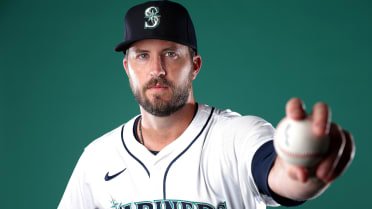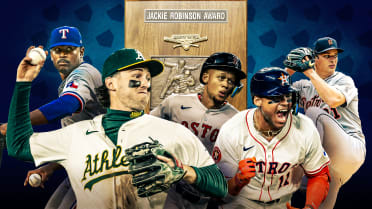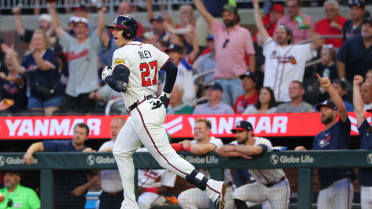Mookie Betts is the best all-around right fielder in baseball, and he's almost certainly going to win the American League Most Valuable Player Award when it is announced next month. He just finished off a season that is legitimately one of the best in Red Sox history, and he did so as one-third of a Boston outfield that may have been one of the strongest on record.
:: World Series schedule and results ::
You'd think that all Red Sox manager Alex Cora would need to do for the World Series would be to write "Betts, RF" atop his lineup, as he did 115 times this year, plus 13 more in center field and three more at designated hitter. But the Fall Classic is no time to think small, because there's a chance that for tonight's Game 3 in Los Angeles, Betts may be penciled into the lineup at second base, a position he hasn't started at in more than four years.
There's a chance Betts might not be, too, since Cora had said the odds are "very slim." And on Thursday he ruled out Betts starting at the position.
"Well, he's not starting at second," Cora said.
Still, it's a wild, borderline-historic idea -- and it's the right one. Even if the Red Sox don't do it, let's explain why they ought to.
Because second base in Boston is the perfect position to try this with
If there was the risk of significantly impacting Boston's defense, this would never be considered. You would never, say, put Xander Bogaerts at catcher or Steve Pearce at shortstop.
But in today's world of shifting and strikeouts, defensive needs aren't what they once were. The Dodgers had the third-lowest ground-ball rate in the Majors, for one thing. For another, there's an argument that the keystone in Boston just doesn't find itself in the middle of the same kind of traffic as the position does for other teams. Looking at the Statcast™ data, no pitching staff allowed fewer balls hit to the second-base area of the field -- importantly, this is different than to the second baseman, given how shifts have given rise to the idea of position-less baseball -- than the Red Sox.
Look at what's happened around the sport, really. This is a season where Travis Shaw shifted from third base to second in the middle of the season, with no prior experience, and performed admirably there. Among the list of those who played at least 10 games at second base this year, you'll find Shaw, Player Page for Max Muncy, Yuli Gurriel and Matt Carpenter (primarily first basemen), and Daniel Murphy (33 and coming off serious knee surgery). If they made it work for weeks or months at a time, surely Betts can for a few innings -- especially because any arrangement is unlikely to last for a full nine innings once double-switches come into play.
All of which means we're talking about how many chances Betts would be likely to receive at second base in six or so innings. Based on our chart above, there were slightly more than three balls per game hit to the second-base area, but that assumes a full nine innings. When Betts had a brief cameo at the position in August, he fielded two ground balls in six innings. Two or three sounds like a reasonable expectation. (This doesn't account for the difficulty in turning double plays, however.)
Basically, this alone gives Cora cover to do this if he chooses to go ahead with it, and it's not like it would be unprecedented. Betts at least has some experience at the position, which is more than Carlos Santana could say when Cleveland gave him a pair of starts in left field in the 2016 World Series, a position he'd never started at before. (He caught four balls without incident.)
Because he's done it before
Importantly, it's not like Betts has no meaningful experience at the position, like Santana did. Betts was drafted as a shortstop and got into 230 games as a Minor League second baseman, compiling nearly 2,000 innings there. As a rookie in 2014, he started 14 big league games for the Red Sox when Dustin Pedroia was injured, and he got back there for six innings in August when Ian Kinsler was injured.
"It was like a dream come true," Betts said at the time. "I think it's been since 2014 since I've been in the infield. That's why I take my ground balls and all that area work, just in case."
Remember, Betts was only moved off the position in the first place because of the presence of Pedroia, who is signed through 2021, rather than due to any inability to handle it defensively. He only just turned 26 earlier this month, and it hasn't been that long since he was an infielder. This isn't Ryan Braun returning to a third-base spot he proved unable to play, or Jose Pujols returning to the outfield many, many years after he'd last tried it. This is reasonable.
Because second base isn't a strong position for the Sox
This wouldn't be a conversation if the Red Sox had a strong second baseman, but they don't, not really. As a group, Boston second basemen -- mostly Brock Holt, Eduardo Nunez and Kinsler -- hit only .258/.310/.370, the fifth-weakest production at the position in the Majors. Kinsler went 0-for-4 in Game 1 and 1-for-3 in Game 2, and he hasn't been a league-average hitter since 2016.
When you have too many good-hitting outfielders and not enough second basemen, this is the kind of discussion that is going to happen. And they do have too many outfielders, four for three spots, which is a problem when the series shifts to Los Angeles.
Because J.D. Martinez is that good
It's not hard to understand where the impetus behind this idea is coming from, anyway. In Games 1 and 2 at Fenway Park, played under AL rules, Cora deployed Martinez as his DH, just like he always does. But in Games 3, 4 and potentially 5 in Los Angeles, the DH goes away. The pitcher has to hit.
Of course, you can't simply bench Martinez, who hit .330/.402/.629 with 43 home runs, a line that made him the third-best hitter in baseball this year behind Michael Trout and Betts. While he's a poor defender (negative-7 Outs Above Average, similar to Matt Kemp or Curtis Granderson), he's not unplayable, and he did play 493 innings in left and right field for the Red Sox this year. Martinez did roll his right ankle in Boston's Game 1 victory, which could be a factor, but it didn't prevent him from hitting a go-ahead two-run single in Game 2.
Simply put, any Boston lineup that does not have Martinez hitting third or fourth is one that will make Dave Roberts very happy.
Against lefties Rich Hill in Game 4 and Clayton Kershaw in Game 5, the decision is simple. You bench center fielder Jackie Bradley Jr., who hit only .185/.260/.303 against lefty pitchers this year, insert Martinez into right field and slide Betts to center. Bradley would then be available late in the game for defensive purposes or to hit when a righty reliever is brought in.
You could do that against righty Walker Buehler in Game 3, too. It's easy. But Bradley (+11 Outs Above Average) is one of the best defensive center fielders in the game, and he was a league-average hitter against righties (.251/.332/.437) this year, with a second-half power surge against righties (.301/.369/.531) that promises much more. In addition to Cora not being likely to want to sit Bradley three games in a row, his case to start against the lone righty in non-DH games is a far stronger one.
It's the same issue in left, where lefty Andrew Benintendi has some strong platoon splits of his own, hitting only .247/.301/.393 against lefties but a strong .305/.387/.490 against righties. You aren't benching him against Buehler, either. Obviously Betts is going to play. You have to find a way to get Martinez in. It's not that "too many good players" is really a problem, but decisions have to be made. What do the Red Sox do?
With four players for three spots, and Betts and Martinez both absolute musts to be in the starting lineup, Cora is really left with only two options.
1. Start Holt at 2B, Betts in CF, Martinez in RF, bench Bradley and Kinsler.
2. Start Betts at 2B, Bradley in CF, Martinez in RF, bench Holt and Kinsler.
(In our first scenario, Holt starts at second base when Betts does not, with Kinsler sitting, because of the platoon advantage the lefty Holt has over the righty Kinsler, but also because Kinsler hasn't hit in two years and Holt was outstanding over the season's final two months.)
As we noted above, you probably don't want to bench Bradley in this game, but we can run the numbers anyway.
The first trio -- Holt (2B)/Betts (CF)/Martinez (RF) -- hit .320/.402/.582 against righties, good for a .984 OPS and a 160 wRC+.
The second -- Betts (2B)/Bradley (CF)/Martinez (RF) -- hit .309/.391/.571 against righties, good for a .962 OPS and a 154 wRC+.
That's incredibly close, and given Bradley's late-season improvements, it gets closer: The first group had a .967 OPS and a 155 wRC+ in the second half, and the second group had a .963 OPS and a 154 wRC+ in the second half. It is, essentially, tied. It means that the choice (on offense, at least) is about whether you prefer Holt or Bradley, and the truth is, it may not really matter. They're both lefty swingers who had weak first halves and much better second halves; they both have value off the bench.
So if the lineup choices are a wash, this comes down to defense. Martinez is a sizable step down from Betts in right, but he's got to be there if we want his bat in the lineup. Betts is likely a small step down from Bradley in center, probably a barely perceptible one, but that matters with Martinez in right. And at second, Holt is worse than Kinsler, but better than Betts. You could argue in either direction. Either way, Betts and Martinez must both play, and Bradley's defense is more valuable than Holt's.
Maybe putting Betts at second base is too radical for the World Series. Perhaps Cora will just keep it simple and bench Bradley, starting Holt or Kinsler at second base. It's the easy way to go, and Red Sox fans know better than most how hard one poorly-timed defensive miscue can sting. But October is when the tough choices mean the most. Putting Betts at second is far from traditional. It just might be the right thing to do.
Mike Petriello is an analyst for MLB.com and the host of the Statcast podcast.



